The works of renowned sculptor Greg Wyatt ’71 grace public spaces from Morningside Heights to Florence.
Columbia College | Columbia University in the City of New York
The works of renowned sculptor Greg Wyatt ’71 grace public spaces from Morningside Heights to Florence.
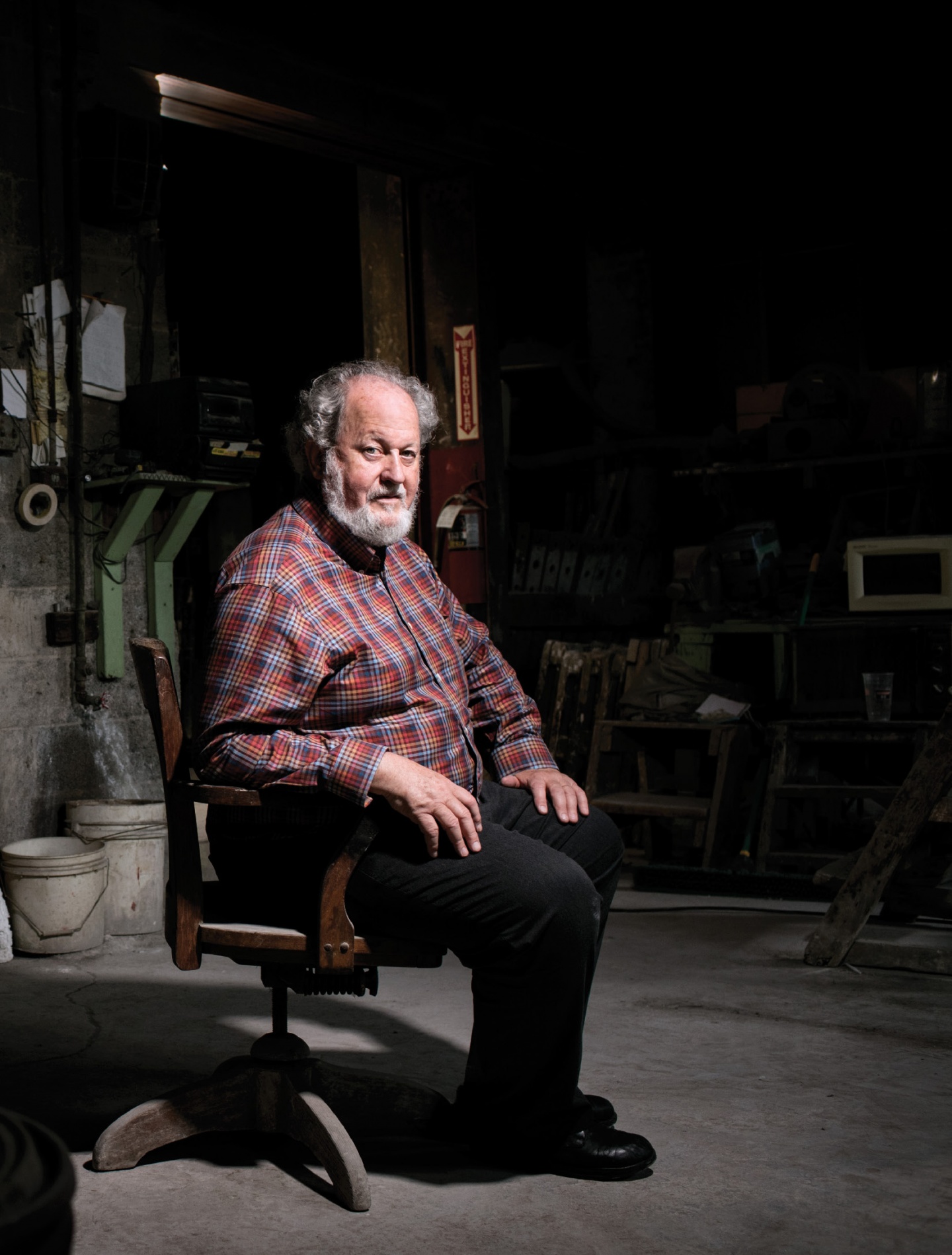
As visitors to The Cathedral Church of Saint John the Divine approach the massive bronze Peace Fountain on the cathedral grounds at West 111thStreet and Amsterdam Avenue, they naturally are drawn around the sculpture. They might not even realize they are on a mission of discovery. The work’s creator, renowned sculptor Greg Wyatt ’71, TC’74, placed the work’s central figure, St. Michael, rotated 90 degrees away from the viewer as he or she enters the cathedral close from Amsterdam.
“It sets up a question, very much as in Shakespeare’s Hamlet: ‘Who’s there?’” Wyatt says. “There’s a lot of psychological curiosity about what the sculpture is about. It draws people in.”

PEACE FOUNTAIN
Bronze, 40 ft. high, 1985
Cathedral Church of Saint John the Divine, New York City
“My Sculptor-in-Residence studio, situated in the crypt below the Saint James Chapel of the Cathedral Church of Saint John the Divine’s sacred architecture, was the creative location of Peace Fountain, which celebrated the 200th anniversary of the Episcopal Diocese of New York. It was also the impetus for the founding of 30 years of sculpture internships for younger generation artists of NYC.”
Wyatt, sculptor-in-residence at the cathedral since 1982 and known for his public works throughout the United States and Europe, has for his whole career been inspired and guided by what he learned as a student of the Core Curriculum and art history. His knowledge of poetry, classicism, Shakespeare, Italian Renaissance masters and even architecture all inform his work. For example, Wyatt’s orientation of Peace Fountain was taken directly from lessons learned about the Parthenon in the first semester of Art Humanities his freshman year.
“If you were about to climb the Acropolis, the temple is rotated from the viewer,” he says. “You want to see more; it piques your curiosity. This curiosity in perpetuity motivates most people to go to the top.” Likewise, it motivates most visitors to Peace Fountain to walk around it to discover its depiction of the ongoing victory of good over evil.
Simultaneously, they are drawn into Wyatt’s artistic world of classicism meets realism. As described by Walter Liedtke, then the curator of European paintings at the Metropolitan Museum of Art, in a catalogue of Wyatt’s work, “His forms are seen immediately as coming from another age, and perhaps from another world, in which human figures, natural forms and natural or even cosmic forces flow together, as they might in dreams, in floods, or cascades of water, or in poetry (to which Wyatt has long been devoted).”

ARTIST’S MYTHICAL PORTRAIT
Rapidograph pen and ink on watercolor paper, 23.5 in. × 17.5 in., 1969
Collection of the Artist
“In an artist's youth there exists many envisioning opportunities to sense the coming depths of nature's changes, and we as artists can trust sensations that absorb us in nature's interiority modeling.”
Wyatt grew up in Grand View-on-Hudson, less than an hour north of Manhattan. The Hudson Valley area was home to the mid-19th-century Hudson River School of landscape painters, whose work became a major influence on Wyatt’s art. His mother, Alice, was a homemaker and gardener; his father, Stanley ’43, GSAS’47, was a painter and fine arts professor at Columbia and CUNY’s City College — he taught Columbia’s Meyer Schapiro Professor Emeritus of Art History David Rosand ’59, GSAS’65 (now deceased), who became Greg’s adviser and mentor.
Greg learned master techniques in drawing from his father when he was 4 or 5. By the time he was 12 or 13, Wyatt knew he wanted to pursue a career in the arts. What form that would take was determined on a family trip to Mexico in the early ’60s. “The first epiphany I experienced in art was the three-dimensional architecture of the Mayans,” he says, referring to the family’s visit to the Mayan ruins at Palenque. He was especially intrigued by the bas-relief forms on the faces of the temple executed in what he calls “two and a half dimensions.” From then on, he turned his artistic attention to sculpture, starting by working in terra cotta through his teens and at Columbia.
While an undergraduate, Wyatt taught drawing and then ceramics at Riverside Church’s arts and crafts program, a popular community program for adults. “The studio on the 14th floor became my studio for the next four years, while being paid to be an instructor,” he says. At the same time, he discovered what he calls the incredible ceramics department at Teachers College, where he says the facilities are among the best in the country.
An art history major, Wyatt says he was heavily influenced by the Core Curriculum. “The Core exposed me to the art historical concepts, scholarship and poetry of humanities and literature,” he says. “A lot of my career has been visualizing concepts found in Dante and Shakespeare and Yeats and Dylan Thomas.”
Wyatt has nine bronze Shakespeare works installed at the Great Garden at New Place, Shakespeare’s home in Stratford-upon-Avon. (Several versions are at the Folger Shakespeare Library in Washington, D.C.) Two of them were unveiled in 2007 by then-Dean of the College Austin E. Quigley.
“These images are not like still-life portraits or posed photographs,” Quigley wrote of the works in the catalogue of “Two Rivers,” a 2009 retrospective of Wyatt’s work in Florence. “They depict life in motion, but motion arrested at an emblematic point, like that of a runner breaking a tape.”
“A lot of my career has been visualizing concepts found in Dante and Shakespeare and Yeats and Dylan Thomas.”
Wyatt’s art history education at Columbia also taught him how to view art and absorb its lessons. He says he regularly spends an hour or two in front of a single work, in various museums: “Paintings, crafts, sculpture — everything. I analyze the inner composition, and how the story is being told. What are the elements of discovery?”
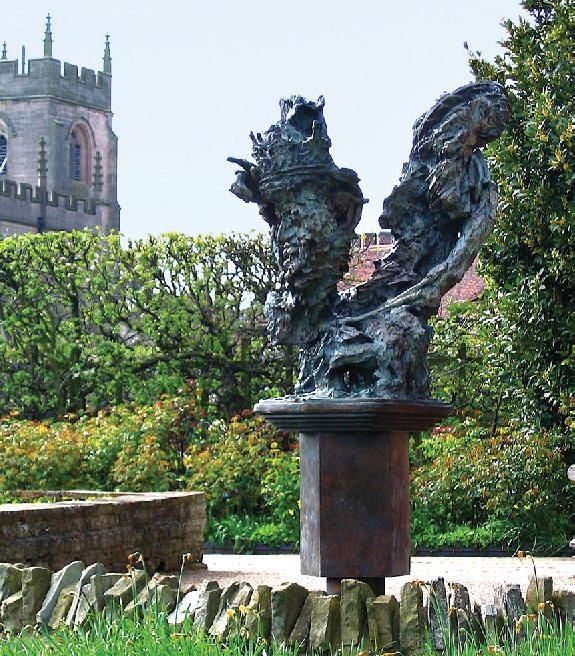
KING LEAR
Bronze, 8.5 ft. high, 2001
Shakespeare Birthplace Trust, Shakespeare’s Great Garden at New Place, Stratford-upon-Avon, United Kingdom
“Inspired by interdisciplinary notions of sculptural transformation of poetic words and three-dimensional forms, Professor Stanley Wells, CBE, was the academic adviser to create the Sculpture Trail, nine interpretive permanent bronzes in Shakespeare’s Great Garden at New Place.”
After graduating from the College, Wyatt earned an M.A. in ceramic arts from TC while studying sculpture for three years at the then-named National Academy of Design’s School of Fine Arts. He continued at TC, pursuing a doctorate in arts education, but a second career epiphany led to his discontinuing in 1976.
The revelation occurred during a weekend trip to Florence — his first time there — during the summer as he was teaching ceramics in San Marino. He was inspired by the city’s open air sculptures; Casa Buonarroti, Michelangelo’s museum; and the Bargello, a museum featuring Renaissance sculpture. At the last, he was especially taken with the bronze and terra cotta models by Michelangelo and Cellini.
“It was my first exposure to ‘models to monument.’ It became a fascination,” Wyatt says. “The slides in Art Hum were good, but, just as I’d discovered in Mexico, there’s no substitute for viewing original masterpieces.”
Wyatt had always drawn, but upon that visit to Florence he took it up as a daily practice. He also became a prolific watercolor painter — he often takes an easel into the field — and has framed about 800 of his works for his own collection. Above all, his experience in Florence inspired him to resign from teaching and join the New York art world as a sculptor.
Wyatt achieved early success. His first public work, unveiled in 1978, was the result of winning a competition to create a 10-ft. high by 10-ft. wide rendition of the logo — the American bank note eagle — of the American Bureau of Shipping for its headquarters on lower Broadway. His Art Hum education with Professors Howard McP. Davis and Everard Upjohn was probably to thank. “Notable in my memory is Professor Upjohn’s analysis of classicism as it relates to architecture and especially embellishments and the underlying ideal geometry of sculptures,” Wyatt says. Upjohn revealed, for example, that the friezes on the Parthenon were thicker at the top and thinner at the bottom to compensate for their being viewed from below. Wyatt incorporated that knowledge into his plans for the eagle.
“When I interviewed with the architect of the American Bureau of Shipping, I recognized that the placement would be 200 ft. above Broadway,” Wyatt says. “So I explained that as with the Parthenon friezes, I would have to sculpt with the compensating distortion, but that as the crane pulled the work up higher and higher, it would become recognizable.”
He won the job.
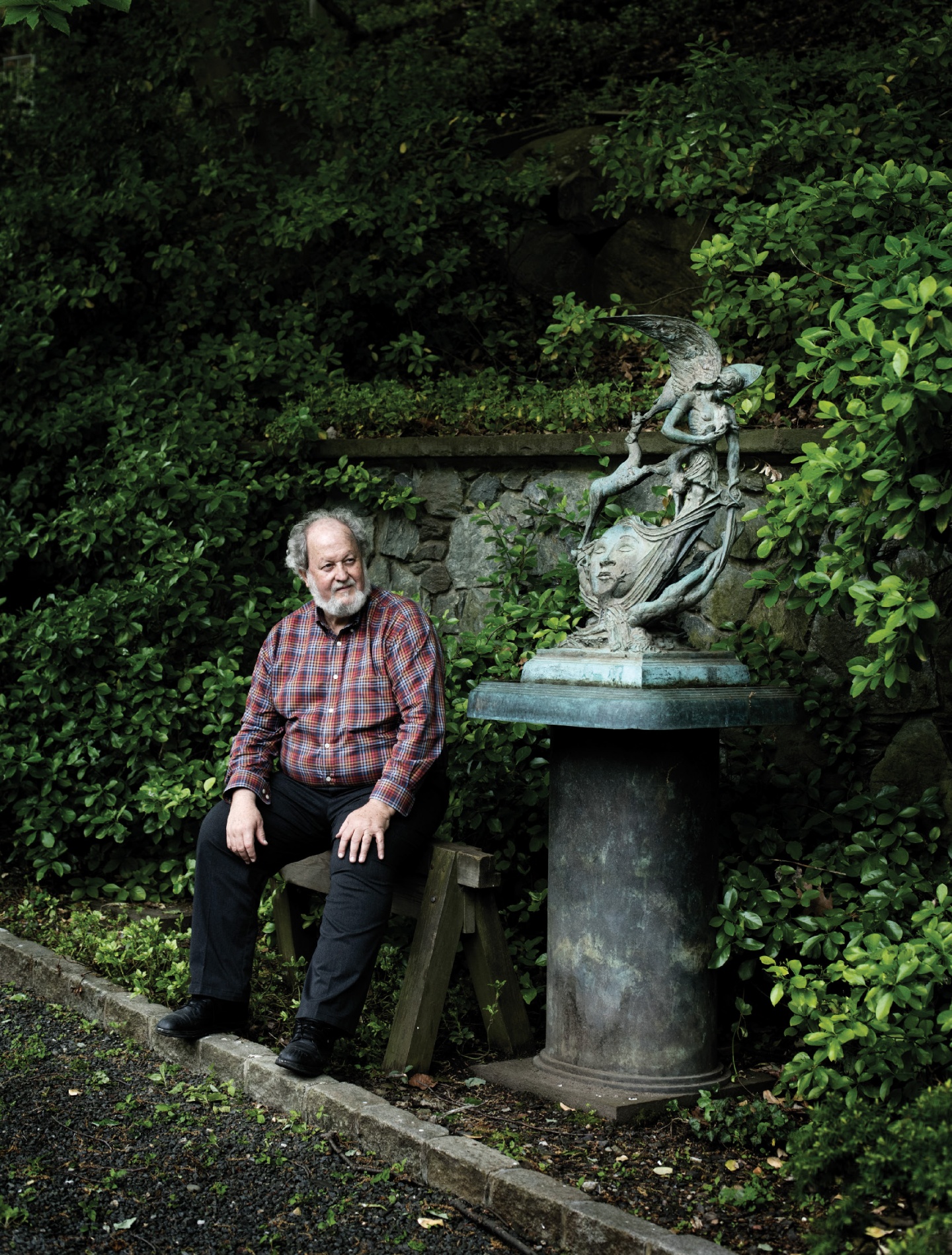
PEACE FOUNTAIN (MODEL)
Bronze, 44.5 in. high, 1983
Newington-Cropsey Foundation, Academy of Art, Hastings-on-Hudson, N.Y.
“In late December 1983, a unanimous Board of Trustees' decision was announced by the dean of the Cathedral of Saint John the Divine, James Parks Morton, approving the Peace Fountain bronze monument for permanent placement on the close of the Cathedral. The proposed bronze model was present and referred to during the Board of Trustees' meeting within St. John's Diocesan House.”
Wyatt was inspired by Florence’s open air sculptures; Casa Buonarroti, Michelangelo’s museum; and the Bargello, a museum featuring Renaissance sculpture.
That first grant was for Fantasy Fountain, a 53-inch model for the main elements in Peace Fountain. Wyatt won a city-wide competition sponsored by the NYC Department of Parks and Recreation and the East 96th Street Association to create the sculpture. It was unveiled at the East 96th Street playground in Central Park on October 31, 1982, but was ultimately installed, on long-term loan, in Gramercy Park, where it resided for more than 30 years before being acquired for a private collection. The artist proof will be placed permanently in the garden of the Peace Fountain later this year.
While Wyatt was working on Fantasy Fountain, he was introduced to the then-dean of Saint John the Divine, James Parks Morton, who wanted to learn more about his work. What resulted was Wyatt’s appointment as the cathedral’s third sculptor-in-residence, a position that comes with studio space, public recognition and the opportunity to be involved in cathedral arts education programs — but no actual requirements. The sculptor promptly made his professional home in the crypt studio below the cathedral’s St. James Chapel, where he created his models for the next 28 years, until he had to uproot for an ongoing renovation (in the meantime, he works mainly out of a prestigious duplex studio awarded him at the National Arts Club in Gramercy and at the Newington-Cropsey Foundation in Hastings-on-Hudson).
Wyatt became a prolific sculptor in bronze, with works displayed in gardens, museums and other public spaces, and also in corporate and private collections, across the U.S. and in the United Kingdom, France and Italy, the last of which has become somewhat of a second (artistic) home for him.
“Greg is a combination of many influences in art,” says Robin Salmon, VP and curator of sculpture at Brookgreen Gardens, a sculpture garden in Murrells Inlet, S.C., that has three of Wyatt’s works in its collection. “He’s a fine art historian and quite a scholar of American art history and also of the casting process — his technical side is highly developed and his art work shows that. Sculptors who look at his work recognize the various techniques he has used and the sometimes-daring decisions he’s made.”
Wyatt casts in bronze with the lost-wax method, usually at the Modern Art Foundry or the Fonderie de Coubertin — fiery worlds of furnaces, molten metal and blowtorches.
Wyatt works 6½ days a week in his Upper West Side home, rising at 5:30 a.m. to start each day with a five-hour block of creative work. At a minimum, even when traveling (he takes four or five business trips to Europe each year), he keeps a journal in watercolor, part of his dedication to daily practice. Around 2 p.m. he turns to the administrative side of his enterprise. “Artists have to learn to be good administrators, especially if they’re doing several model-to-monument commissions at a time,” Wyatt says. He works on three to five projects at any one time, which include meetings to models to casting to unveiling. At the moment those include the homage sculpture portraits of the Hudson River School painters, one or more sculptures of French literary geniuses for the Institute for American Universities in Aix-enProvence, and Don Quixote/King Lear, being installed outside of Madrid.
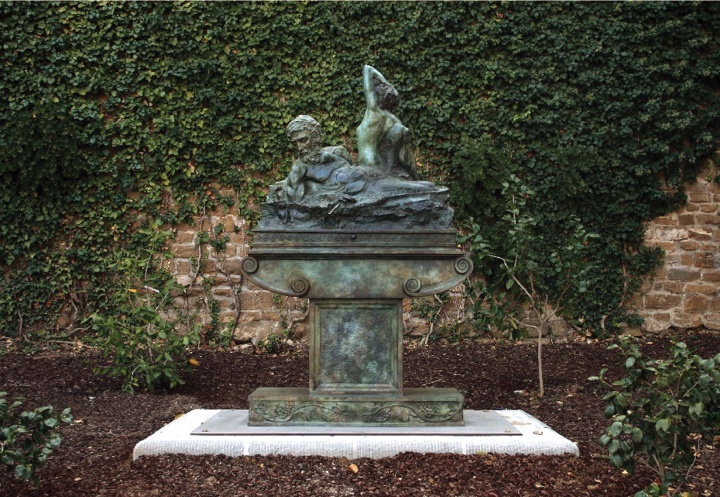
NOVATION
Bronze, 8.5 ft. high, 2007
Giardino Bardini, Florence, Italy
“Inspired by masterpiece renaissance Italian sculpture, Novation is permanently displayed across from the Arno River within the historic Giardino Bardini.”
Creation of his sculptures starts with 9–12-inch models in terra cotta or Plasticine modeling clay. He revises and progresses to larger models, plaster cast, then beeswax, in his studio. “His modeling directly in wax, an old technique that has never gone away, allows him to have exquisite textures,” Salmon says. “The surfaces of his sculptures are so finely detailed, and that’s only possible by working in wax.”
Wyatt then casts in bronze with the lost-wax method, usually at the Modern Art Foundry in Queens or the Fonderie de Coubertin near Paris — fiery worlds of furnaces, molten metal and blowtorches. Wyatt says he is very interested in processes and materials, and started experimenting early in his career at a foundry in Yonkers with metal alloys. “The type of alloy is important because it influences the patina — oxides of copper and ferric nitrate absorb in a different way,” he says. He applies a permanent patina, or “studio patina,” to his works using various techniques with a blowtorch to interpret nature’s oxidation.
In 2013, the artist’s Angel and the Dying Unknown was unveiled at Dover AFB on the grounds of the Center for the Families of the Fallen, a private campus that hosts families of service members who have died in combat zones and whose bodies are being returned home. Family members arrive at Dover AFB shortly after the deaths occur, and the sculpture has become a focal point that seems to help them process their various emotions, according to Brig. Gen. Rick Moore. “It is specifically for the families, and became part of the service we provide. Greg Wyatt brought that all together,” Moore says.
Much like he did with Peace Fountain, Wyatt placed the sculpture so that it draws the families to it and reveals itself in stages. As one walks from the center’s chapel, it is first seen from behind, where it looks like an eagle. Coming around, the viewer sees the side profile of an angel and a person’s head being held. Continuing to the front, the angel is seen cradling a full body. “It was intended to elicit emotion,” Moore says. “What was impressive to me was [that Wyatt’s involvement] went far beyond the work of art. It was the way the art relates to the surroundings: the placement, the pavers, the landscaping — all were designed by Mr. Wyatt to have an emotional impact on the families. It made a powerful emotional impact on me, and part of that was Mr. Wyatt and the care he took.”
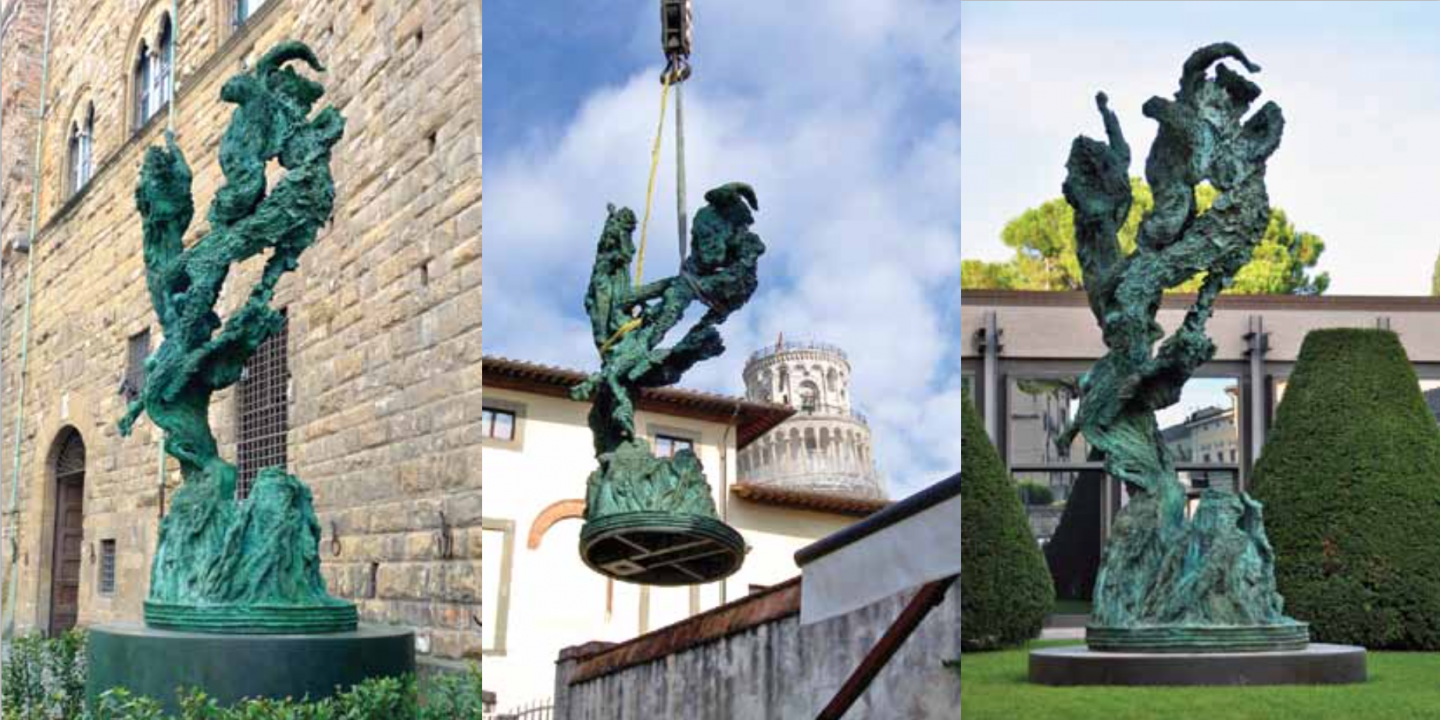
TWO RIVERS
Bronze, 17 ft. high, 2010
Museo dell’Opera del Duomo, Pisa
“As a component ‘open air’ bronze monument in homage to the historic rivers Arno and Hudson, Two Rivers was displayed in Florence next to the Fountain of Neptune at Piazza della Signoria during the sculpture retrospective spanning 30 years at Sala d’Arme in Palazzo Vecchio (far left). It is now permanently placed near the Leaning Tower of Pisa within the gardens of the museum (far right).”
Kathleen Jansyn is one of the artists Wyatt mentored in the Model to Monument program last year. “While giving advice, he tried very hard not to influence the individual artistic choices,” she says. “His point was always to help us get clear about our own intentions and the artwork we envisioned.” Although she had worked in intimate scale sculpture, Jansyn says as a result of the program and her experience working with Wyatt, she is interested in exploring public art as a medium.
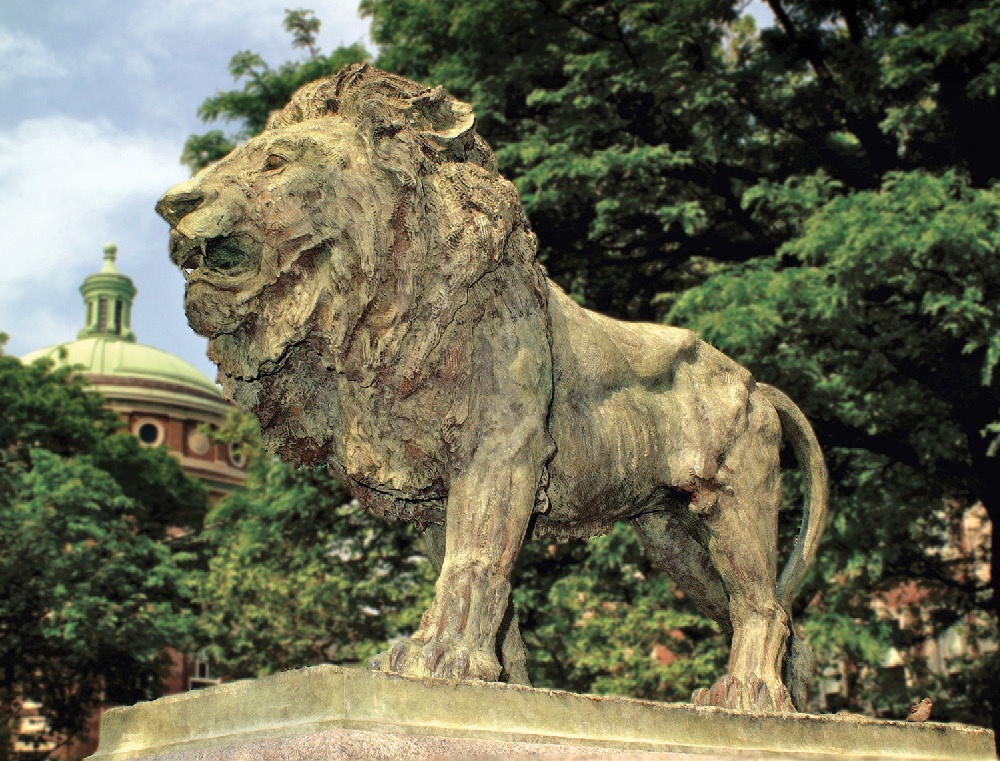
SCHOLAR’S LION
Bronze, 9 ft. high, 2004
Columbia University in the City of New York
“The unveiling of the permanent work celebrated the 250th anniversary of Columbia University. Imbued in its Lion design and expression is an overarching courageous theme mirroring the University’s deep respect and institutional vigilance for academic freedoms, research and publishing.”
Wyatt is also very engaged with Columbia, through his class reunions (he celebrated his 45th anniversary reunion in early June) and the Department of Art History and Archaeology. Through his own Fantasy Fountain Fund, and his connections as a member of the Royal Academy of Arts in London, he supports a summer research fellowship at the Royal Academy of Arts for a Columbia Ph.D. student that covers a stipend plus studio/office space at the academy and access to its library. Through his position as director of the Academy of Art at the Newington-Cropsey Foundation, he arranges fellowships for undergraduate fine arts and art history students to travel to Italy for an art immersion program.
“He’s interested in helping in a selfless manner,” says Holger Klein, former chair of the Department of Art History and Archaeology. “He’s dedicating proceeds from his own work [to give] back to the College for the benefit of the campus and the students.” For Class of 1971 reunions, Wyatt has hosted events at his cathedral studio and Bloomberg and arranged for a private tour of The American Wing of the Met. “He’s a committed Columbian and is very committed to our class,” says Trustee Emeritus Philip L. Milstein ’71. “He’s been a wonderful person to work with on reunions. He’s opened a lot of doors in the nicest way.”
“What was impressive to me was that Wyatt’s involvement went far beyond the work of art. It was the way the art relates to the surroundings: the placement, the pavers, the landscaping — all were designed to have an emotional impact.”
Probably Wyatt’s most enduring contribution to the Columbia campus is his larger-than-life Scholar’s Lion, which stands near Mathematics, Havemeyer and the campus entrance to Levien Gym. It was donated by the Class of 1971 and several individual alumni for the University’s 250th anniversary in 2004. Wyatt mentions it as a high point of his career. In 2009, Wyatt was presented a John Jay Award for distinguished professional achievement.
He says he looks forward to returning to his crypt studio at Saint John the Divine when renovations are complete. He was introduced by friends to his wife, Fay, a painter, in that studio 14 years ago.
Peace Fountain’s water feature was turned off about five years after its unveiling because the water was blowing as far as across Amsterdam Avenue. Since then, the pool surrounding it has featured a garden. An engineer has been recruited to solve the issue, however, and next year the cathedral will hold a rededication of the sculpture and a celebration of the return of the fountain waters.
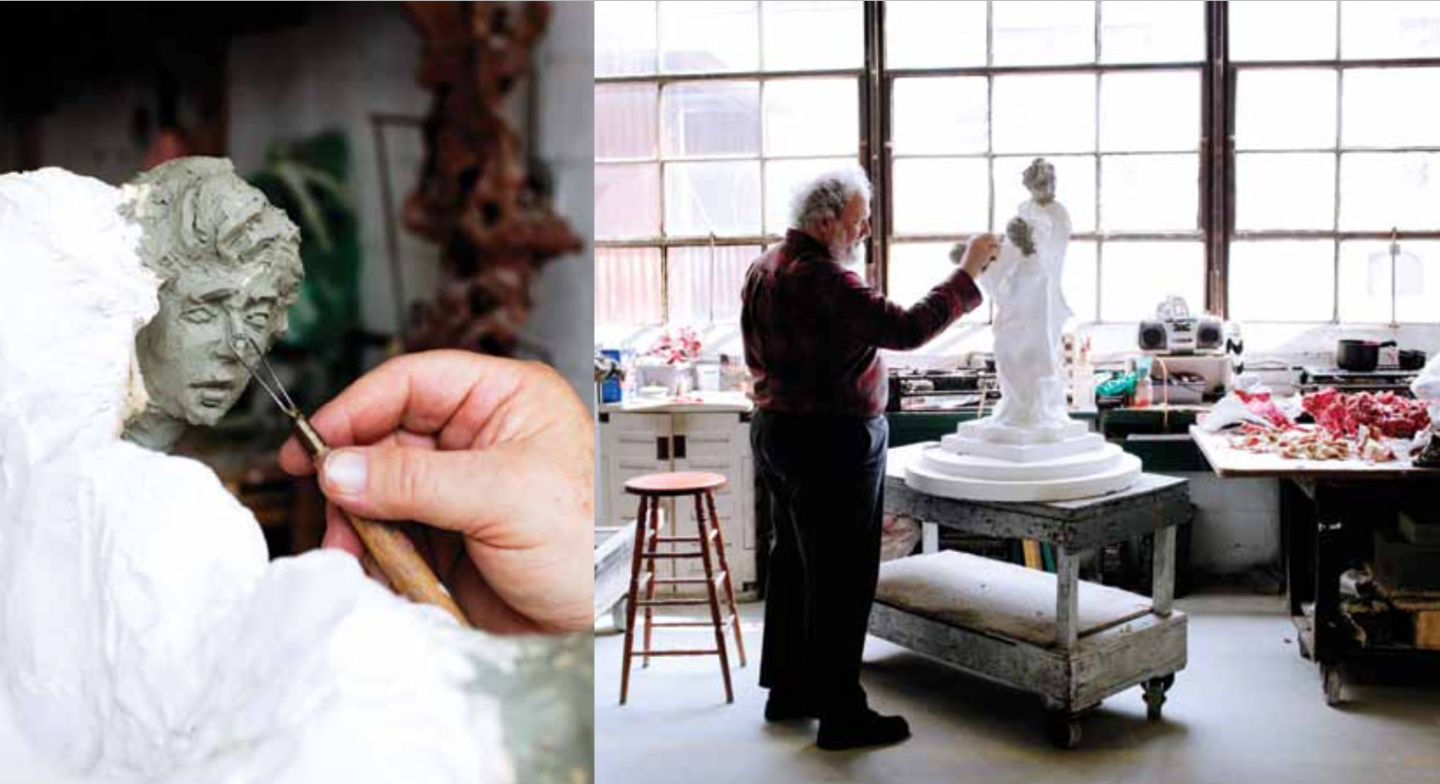
Shira Boss ’93, JRN’97, SIPA’98 is an author, contributing writer to CCT and writer of Zero Cost Kids, a website with tips and support for living simply with children. She lives with her husband, two sons and two whippets on the Upper West Side in less than 650 sq. ft.

Published three times a year by Columbia College for alumni, students, faculty, parents and friends.
Columbia Alumni Center
622 W. 113th St., MC 4530, 4th Fl.
New York, NY 10025
212-851-7852
cct@columbia.edu

Columbia Alumni Center
622 W. 113th St., MC 4530, 4th Fl.
New York, NY 10025
212-851-7488
ccalumni@columbia.edu